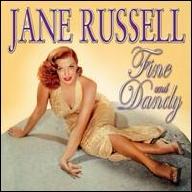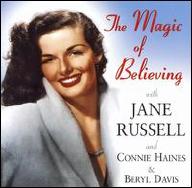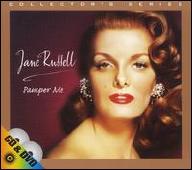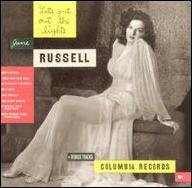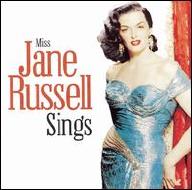Ernestine Jane Geraldine Russell was born at the summer home of her maternal grandparents in Bemidji, MN, on June 21, 1921. She was the first of five children and the only girl born to Roy William Russell, who soon became an office manager for the Jergens soap company, and Geraldine (Jacobi) Russell, a former actress who later taught elocution. Russell was always called by her second name; her mother had chosen it because she thought "Jane Russell" would look good on a marquee. At the time of her birth, Russell's parents lived in Canada, but they moved to Glendale, CA, when she was nine months old, later moving to Burbank and, when she was 12, to a farm in Van Nuys. Russell took piano lessons as a child and developed an interest in acting that led her to attend two drama schools after she graduated from Van Nuys High School in 1939. Her stay at the Theatrical Workshop run by Max Reinhardt was brief, but she spent six months at Maria Ouspenskaya's School of Dramatic Arts. After that, she found work modeling and was given screen tests at some of the movie studios. In the summer of 1940, at the age of 19, she was cast in a starring role in #The Outlaw, a Western about Billy the Kid being made by the eccentric aviator, inventor, business executive, and movie producer Howard Hughes, and she signed a seven-year contract with Hughes.
Veteran director Howard Hawks began work on #The Outlaw, but soon fell out with Hughes, who took over the direction of the film himself as the shooting schedule extended over nine months. Meanwhile, a publicity campaign emphasizing provocative photographs of the buxom Russell made her a star long before the movie appeared. Hughes revealed his interest in Russell's curves as the movie's selling point by designing a seamless bra for her to wear. She didn't use it, but the camera still caught plenty of her cleavage, and Hughes spent two years arguing with the Hays Office, Hollywood's censors, before he managed to get a limited release for #The Outlaw in San Francisco in February 1943. Even then, it did not get much distribution, appearing again in 1946, 1947, and 1950. When it could get into theaters, however, it was popular, eventually ranking as the third most successful film released in 1943.
On April 24, 1943, Russell married her high-school sweetheart, Robert Waterfield, who was at the time a student at UCLA and the quarterback of the college football team. He went on to a successful professional football career with the Los Angeles Rams as a player and a coach. Russell continued in the odd position of being a movie star whose one movie had barely been seen until 1945, when Hughes loaned her out to United Artists to star in the drama #Young Widow, which opened in 1946. As part of this deal, United Artists sponsored the second release of #The Outlaw, and Russell accompanied showings of the film in Chicago, Atlantic City, and Boston, singing in public for the first time. Her singing was well received, and she accepted an offer from bandleader Kay Kyser to perform on his radio program, Kay Kyser's Kollege of Musical Knowledge, on NBC, replacing his regular female singer, Ginny Sims, who had left the band to go solo. Kyser also sent Russell to a vocal coach; he was sufficiently impressed with the results to sign her for 12 weeks of appearances and, on January 8, 1947, to use her on a recording session that produced the single As Long as I Live, released by Columbia Records, her recording debut. After a second session resulted in another single, Boin-n-n-g!, Columbia signed Russell to a solo contract, and in July she recorded eight torch songs for her four-disc, 78-rpm debut album, Let's Put Out the Lights.
At the end of 1947, Russell's contract with Hughes was set to run out and, despite the lack of work it had brought her, she re-upped for another seven years. Perhaps Hughes shared his plans with her; on May 10, 1948, he bought the RKO film studio, assuring her of plenty of work during her second contract. That work began with another loan-out, this time to Paramount, where she co-starred with Bob Hope in the Western comedy #The Paleface. #The Paleface, which went on to become the third biggest box office hit of the year, demonstrated her talent for comedy and for singing, as she got to join Hope on Buttons and Bows, which won the Academy Award for best song. After finishing work on the film, she made her nightclub debut at the Latin Quarter in Miami Beach, but her engagement was canceled after a misunderstanding with the club owner, who objected to her impromptu appearance "in street clothes" at a local beauty contest. She would return to nightclub work later. Meanwhile, she went into production on her first RKO feature, a Western called #Montana Belle. Unfortunately, the film was shelved and did not turn up in theaters until the fall of 1952. A similar fate befell the fifth film she shot, #Double Dynamite, in which she co-starred with Frank Sinatra and Groucho Marx. Made in the winter of 1948-1949, it didn't open until the fall of 1951. This fact notwithstanding, Columbia promptly and prematurely released a single of Kisses and Tears, a song from the picture, after Sinatra and Russell recorded a studio version of it in February 1950.
No stranger to having her work left in the can after so many years with Hughes, Russell simply went on to her next film project, a crime drama with Robert Mitchum called #His Kind of Woman. In November 1950, she did a recording session for London Records that included the two songs to be featured in the film, Five Little Miles from San Berdoo and You'll Know. The movie, the sixth she had shot but only the fourth to be released, appeared during the summer of 1951. On June 21, 1951, her 30th birthday, she and her husband adopted a newborn baby girl. They adopted a boy four months later, and in 1956 added another son. Russell became an adoption activist, working to ease restrictions internationally, and founded an organization with that purpose, the World Adoption International Fund (WAIF). Her next film, #The Las Vegas Story, released in January 1952, was a drama in which she got to sing the standards I Get Along Without You Very Well and My Resistance Is Low. In #Macao, another drama with Mitchum released in the spring, she sang three songs, among them One for My Baby. She returned to Paramount, and to Bob Hope, for #Son of Paleface, released in the fall, and she and Hope teamed up for a Capitol Records single of two songs from the picture, Am I in Love? and Wing Ding Tonight. (She also had a cameo in the next Hope/Bing Crosby "road" picture, #Road to Bali.) #Montana Belle finally appeared a few weeks later, and it was accompanied by her single of the song The Gilded Lily, which was featured in the film, on a recording released by American Records.
Russell's film career hit its peak when she was loaned out to 20th Century Fox for #Gentlemen Prefer Blondes, released in July 1953. MGM Records released a soundtrack album on which she sang Bye Bye Baby and Ain't There Anyone Here for Love?, and, with Marilyn Monroe, A Little Girl from Little Rock and When Love Goes Wrong (Nothing Goes Right). The album was a Top Ten hit. Her success in #Gentlemen Prefer Blondes caused RKO to plan its own full-fledged musical for her, and #The French Line appeared in 1954, along with a soundtrack album released by Mercury Records. Meanwhile, she formed a vocal quartet with former band singer Connie Haines, Beryl Davis, and Della Russell to sing gospel songs, and they signed to Coral Records, which released the chart single Make a Joyful Noise Unto the Lord/Do Lord, followed by an LP, Make a Joyful Noise Unto the Lord. Russell also cut a solo single, Forevermore, for Coral, backed with a duet with Johnny Desmond, Backward, Turn Backward. And Della Russell was replaced by Rhonda Fleming for another single by the quartet, Give Me That Old Time Religion/Jacob's Ladder.
Russell made one more picture for RKO, the adventure film #Underwater! released in the winter of 1955, before Howard Hughes sold the studio. Essentially, he was getting out of the motion picture business, but that didn't keep him from re-signing Russell to a new, non-exclusive million-dollar contract that ran 20 years (largely as a means of spreading out payments for tax purposes). Under the terms of the contract, she was to be loaned out to other studios and was able to set up her own production company, which quickly contracted with United Artists, though her next picture, #Foxfire, was a loan-out to Universal. The first film she made under the United Artists deal was #Gentlemen Marry Brunettes, a musical in which she sang standards like Ain't Misbehavin' and for which Coral released a soundtrack album.
#The Tall Men, a Western pairing her with Clark Gable, was made for 20th Century Fox and appeared in theaters about the same time in the fall of 1955. Then she went to Columbia Pictures to play a Gypsy in #Hot Blood, released in March 1956, and on to 20th Century Fox for #The Revolt of Mamie Stover, in which she played a saloon singer and got to sing If You Wanna See Mamie Tonight, which she recorded for a Capitol Records single. At the same time, her company was also producing films in which she did not appear: #Run for the Sun and #The King and Four Queens, the latter starring Gable. Those films, Russell wrote in her autobiography, -My Path My Detours (1985), were financially successful. But the over-budget #Gentlemen Marry Brunettes and her next picture, #The Fuzzy Pink Nightgown (1957), were not. As a result, United Artists became less enthusiastic about new scripts she submitted, and after a few years of rejections, she got the message and closed the company.
Although Russell did a handful of small character parts and cameos in films in the 1960s and early '70s (#Fate Is the Hunter [1964], #Johnny Reno [1966], #Waco [1966], #The Born Losers [1967], #Darker Than Amber [1970]), her career as a major movie star was over as of 1957, when she was 36 years old. In her autobiography, she summed up her screen work accurately. "The films that didn't displease me and which I especially enjoyed doing were #The Fuzzy Pink Nightgown, #Gentlemen Prefer Blondes, [#Paleface, #Son of Paleface], and #The Tall Men," she wrote. "Other than those, I got little artistic satisfaction from my work. Howard Hughes was a good and fair boss, but he lacked the artistic taste to do the kind of films I really would have liked to be in, with parts I could get my teeth into. He wasn't the man I needed if I was to have developed into a serious actress. So I really have no idea how far I could have gone in films....I was definitely a victim of Hollywood typecasting."
Fortunately, Russell's Hollywood experience had provided her with the means to launch the second, multifaceted stage of her career. It had made her a star with a well-known name, and it had demonstrated her ability to act, sing, and dance. She was able to use those talents first to mount a nightclub act that she took to the famed Sands Hotel in Las Vegas in October 1957, followed by engagements at the Latin Quarter in New York, the Living Room in Chicago, and other clubs in the U.S. and around the world. Then, there were radio programs on which she sang, backed by Bobby Troup and his quartet, and a single of It Never Entered My Mind and You're Mine with Troup. There was also what was now a gospel vocal trio with Connie Haines and Beryl Davis (Della Russell and Rhonda Fleming having dropped out), which performed in clubs and recorded an album called The Magic of Believing for Capitol in 1957 and a single, Cumana, for Warner Bros. Records in 1961. (After Haines retired, the duo of Russell and Davis sometimes performed.) And Russell recorded a self-titled solo album for MGM Records in 1959.
The other side of her new career was stage acting. As a star, she was an attractive name for many kinds of theater -- regional productions, summer theater, dinner theater -- around the country and overseas. This required an adjustment, of course, since she had done only film acting, and now was required to learn whole scripts and perform them live over and over. But she made the adjustment, and soon was starring in post-Broadway productions of such musicals as +Bells Are Ringing and +Pal Joey. A particular favorite that she performed many times was the 1965 mystery play +Catch Me If You Can.
In July 1968, Russell divorced her husband, Robert Waterfield. She married actor Roger Barrett on August 25, 1968, but Barrett died of a heart attack less than three months later on November 18, 1968. Plunged into grief, she worked sparingly over the next couple of years, but in early 1971 she received an offer that marked the pinnacle of her post-Hollywood career when she was asked to replace Elaine Stritch on Broadway in the musical +Company, playing the part of Joanne and singing the show-stopping number The Ladies Who Lunch. This was her Broadway debut, and she spent six months in the show. Another notable offer in the early '70s came from a bra manufacturer that wanted her to become its national spokeswoman on television commercials, an association she called "a natural." For more than a decade, audiences watched her on TV touting the virtues of the product for "full-figured gals" like herself.
On January 31, 1974, Russell married for a third time to retired Air Force officer and real estate broker John Peoples. (He died on April 9, 1999.) She gradually cut back on her work schedule in the late '70s, settling with Peoples in Sedona, AZ, and later moved to Santa Maria, CA. But she kept her hand in during the '80s. In 1984, she appeared in a continuing role on the NBC television series #The Yellow Rose, and she also resurrected her trio with Beryl Davis and an out-of-retirement Connie Haines for a five-week national tour. On November 12, 1989, she appeared at the London Palladium as part of Stairway to the Stars, a benefit concert for the charity Aid of Action for the Crippled Child, an effort that returned her to record stores when the British First Night Records label released an album of the event in 1995. Jane Russell died of respiratory failure at her home in Santa Maria, CA on February 28, 2011; she was 89 years old. ~ William Ruhlmann, Rovi



